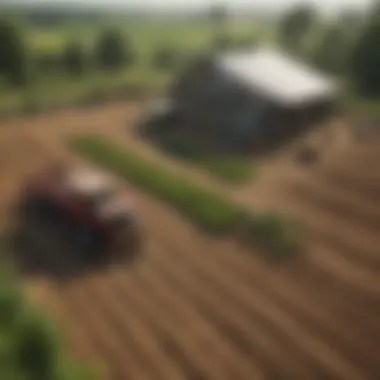Strategic Farm Layout Design: Maximizing Efficiency and Productivity


Optimizing Farm Layout Design: Maximizing Efficiency and Productivity
The focus of this article is to delve deep into the strategic elements of farm layout design, with a keen emphasis on maximizing efficiency and productivity within agricultural operations. It offers a detailed guide from initial layout planning to the fine-tuning of space utilization, providing valuable insights to enhance overall farm performance.
Key Points Discussed
Establishing Strategic Layouts
Before delving into the specifics of farm layout design, defining the strategic objectives is paramount. Various factors such as crop selection, topography, workflow efficiency, and future scalability need careful consideration. Crafting a layout that aligns with these strategic goals sets the foundation for a productive farming environment.
Space Optimization Techniques
One of the fundamental aspects of optimizing farm layouts is efficient space utilization. From crop zoning to equipment placement, every square foot of land should serve a purpose. Implementing techniques like intercropping, vertical farming, and automation integration can significantly enhance productivity while minimizing wasted space.
Technological Integration for Efficiency
The integration of technology plays a pivotal role in modern farm layout design. Utilizing precision agriculture tools, Io T sensors, and farm management software can revolutionize operational efficiency. By harnessing real-time data and analytics, farmers can make informed decisions to maximize yields and streamline processes.
Sustainability and Environmental Impact
An integral part of farm layout optimization is fostering sustainability practices and minimizing environmental impact. Strategies such as rainwater harvesting, solar energy utilization, and organic farming methods not only boost efficiency but also promote eco-friendly farming initiatives.
Continuous Monitoring and Adaptation
Optimizing farm layouts is an ongoing process that requires continuous monitoring and adaptation. Regular assessments of crop performance, equipment efficiency, and workflow dynamics enable farmers to make informed adjustments for optimal productivity. Embracing a mindset of continuous improvement is key to long-term success.
Synthesizing the Information
Through a meticulous exploration of farm layout design strategies, this article underscores the critical importance of maximizing efficiency and productivity in agricultural operations. By strategically planning layouts, implementing space optimization techniques, integrating technology, prioritizing sustainability, and maintaining flexibility for adaptation, farmers can cultivate a thriving and sustainable farming environment.
Understanding Farm Layout Design
In the realm of agriculture, the importance of farm layout design cannot be overstated. It serves as the foundational framework on which all farming operations function. By meticulously planning the arrangement of fields, infrastructure, and resources, farmers can optimize efficiency and productivity levels. Understanding farm layout design involves a deep dive into the intricate balance between spatial organization, operational logistics, and resource allocation within a farming environment.
Importance of Farm Layout Design
Enhancing Operational Efficiency
Enhancing operational efficiency is a key element of farm layout design. It focuses on streamlining workflows, reducing unnecessary movement, and enhancing overall productivity. By strategically positioning fields, equipment storage areas, and access points, farmers can minimize time wastage and increase operational output. The key characteristic of enhancing operational efficiency lies in its ability to reduce inefficiencies and bottlenecks, thereby improving the overall flow of farm activities. While it offers notable benefits in terms of time and resource optimization, it may present challenges relating to initial setup costs and adjustment periods for farmworkers.
Maximizing Crop Yields
The aspect of maximizing crop yields is another pivotal component of farm layout design. By harnessing the influence of field positioning, sunlight exposure, and water availability, farmers can optimize the growth potential of their crops. This approach not only increases the quantity of harvest but also enhances the quality of produce. The key characteristic of maximizing crop yields lies in its ability to extract the full agricultural potential from a given land area. While it is a popular choice among farmers aiming for high productivity levels, it may require intricate planning and continuous monitoring to maintain crop health and soil fertility.


Optimizing Resource Allocation
Optimizing resource allocation plays a crucial role in farm layout design. It involves strategically placing equipment, storage facilities, and livestock areas to maximize operational efficiency. By ensuring that resources are easily accessible in the right locations, farmers can reduce unnecessary movements and streamline their daily tasks. The key characteristic of optimizing resource allocation is its focus on efficient space utilization and resource management. While it offers advantages in terms of cost savings and workflow improvement, it may pose challenges in terms of initial setup investments and possible limitations in expansion flexibility.
Factors Influencing Layout Design
Topography and Land Characteristics
The topography and land characteristics of a farm significantly influence layout design decisions. Factors such as slope gradient, soil type, and natural water sources play a vital role in determining the layout of fields, irrigation systems, and drainage pathways. The key characteristic of topography and land characteristics lies in their influence on farming activities' sustainability and effectiveness. While they offer benefits such as natural resource utilization and landscape harmony, they may present challenges in terms of land leveling costs and limited crop choices based on soil conditions.
Infrastructure and Accessibility
Infrastructure and accessibility are critical aspects to consider in farm layout design. Access to roads, water supply, and storage facilities can greatly impact the efficiency of agricultural operations. By strategically planning infrastructure layouts and ensuring easy accessibility to key areas, farmers can streamline their workflow and reduce transportation time. The key characteristic of infrastructure and accessibility lies in their role as facilitators of smooth farm processes and operational continuity. While they offer advantages such as improved logistics and emergency response readiness, they may pose challenges related to infrastructure maintenance costs and initial setup investments.
Crop Varieties and Rotation
Crop varieties and rotation schedules are essential elements of farm layout design. Selecting a diverse range of crops and implementing rotation practices helps maintain soil fertility, pest control, and overall crop health. By carefully planning the distribution of crop varieties and rotation sequences, farmers can optimize yields and reduce the risk of pest and disease outbreaks. The key characteristic of crop varieties and rotation lies in their contribution to sustainable farming practices and long-term soil health. While they offer advantages such as enhanced biodiversity and reduced chemical inputs, they may require in-depth knowledge of crop requirements and monitoring for optimal implementation.
Goals of an Efficient Layout
Streamlined Workflow
Achieving a streamlined workflow is a primary goal of efficient farm layout design. By organizing field zones, access points, and storage areas in a logical manner, farmers can reduce operational steps and minimize time wastage. The key characteristic of a streamlined workflow is its focus on optimizing task sequences and enhancing overall efficiency. While it offers benefits in terms of labor savings and production time reduction, it may require continuous workflow adjustment and adaptation periods for farmworkers.
Minimized Labor Costs
Minimizing labor costs is a significant objective in farm layout design. By structuring farm layouts to minimize manual labor requirements and optimize machinery usage, farmers can reduce their overall labor expenses. The key characteristic of minimized labor costs lies in its potential for cost savings and operational cost predictability. While it offers advantages such as financial stability and reduced labor dependency, it may present challenges in terms of initial equipment investments and adaptation periods for workforce transitions.
Improved Harvesting Logistics
Enhancing harvesting logistics is a crucial focus area in efficient farm layout design. By strategically locating harvesting areas, storage facilities, and processing units, farmers can streamline the post-harvest workflow and minimize crop handling damages. The key characteristic of improved harvesting logistics is its emphasis on post-production efficiency and quality preservation. While it offers benefits in terms of reduced post-harvest losses and improved product quality, it may require sophisticated planning and investment in mechanized harvesting equipment.
Strategic Planning and Implementation
Mapping Out Field Zones
Dividing into Functional Areas
Dividing the farm into functional areas is essential for efficient utilization of space and resources. This practice ensures that each area is designated for specific functions such as planting, harvesting, or storage. Dividing into functional areas simplifies operations, improves workflow, and enhances overall productivity. The strategic allocation of space based on different functions allows for better organization and management of tasks.
Considering Water Source Proximity
Proximity to water sources is a critical aspect of efficient farm layout design. Placing field zones closer to water sources reduces the time and effort required for irrigation, ultimately leading to water conservation and enhanced crop growth. By considering water source proximity in the layout design, farmers can optimize their irrigation practices and ensure sustainable water usage.


Implementing Crop Rotation Strategies
Implementing crop rotation strategies is vital for maintaining soil health and maximizing crop yields. Crop rotation helps prevent soil depletion, reduces the risk of pests and diseases, and promotes nutrient balance in the soil. By rotating crops in designated field zones, farmers can achieve sustainable agricultural practices and long-term productivity.
Utilizing Technology for Design
GIS Mapping Tools
GIS mapping tools offer farmers a detailed perspective on their land, allowing for precise planning and layout design. These tools provide accurate geographical information, helping farmers make informed decisions regarding field zoning and infrastructure placement. By utilizing GIS mapping tools, farmers can optimize spatial organization and enhance overall efficiency in farm operations.
Precision Agriculture Techniques
Precision agriculture techniques revolutionize farm layout design by enabling precise cultivation methods based on data-driven insights. These techniques involve the use of sensors, drones, and GPS technology to monitor and manage field conditions accurately. By incorporating precision agriculture techniques, farmers can optimize resource usage, reduce wastage, and increase overall productivity.
Automated Machinery Integration
Automated machinery integration streamlines farming processes by automating tasks such as planting, watering, and harvesting. This technology enhances operational efficiency, reduces labor costs, and improves overall output. By integrating automated machinery into the farm layout design, farmers can achieve higher productivity levels and boost their agricultural operations.
Efficient Irrigation and Drainage Systems
Drip Irrigation Setup
Drip irrigation setup is a high-efficiency irrigation method that delivers water directly to the root zone of plants. This system conserves water, minimizes wastage, and promotes healthy plant growth. The drip irrigation setup ensures that water is distributed evenly across the fields, optimizing water usage and enhancing crop yield.
Tile Drainage Installation
Tile drainage installation is crucial for maintaining proper soil drainage and preventing waterlogging. By installing drainage tiles strategically across the fields, excess water is efficiently removed, preventing water-related plant diseases and promoting optimal soil conditions. Tile drainage installation plays a key role in enhancing soil quality and supporting healthy crop development.
Water Conservation Practices
Implementing water conservation practices such as rainwater harvesting and reuse can significantly impact the farm's sustainability. These practices help conserve water resources, reduce water costs, and promote eco-friendly farming. By adopting water conservation strategies in farm layout design, farmers contribute to environmental preservation and long-term viability of their agricultural operations.
Optimizing Resource Allocation
Optimizing resource allocation is a critical aspect of farm layout design, playing a pivotal role in enhancing operational efficiency, maximizing crop yields, and optimizing resource allocation. Efficient resource allocation ensures streamlined workflow processes, minimizes labor costs, and improves harvesting logistics. By strategically planning the allocation of resources within the farm layout, farmers can achieve optimal utilization of available resources, leading to increased productivity and profitability.
Equipment and Storage Placement
Centralized Equipment Storage
When discussing equipment and storage placement, the concept of centralized equipment storage emerges as a cornerstone in the overall farm layout design. Centralized equipment storage involves the centralization of all essential farming machinery and tools in a designated area, typically located for easy access and efficient organization. This approach streamlines operations by reducing time wastage searching for equipment and enables quicker turnaround times during farming activities. The key characteristic of centralized equipment storage lies in its ability to enhance workflow efficiency by providing a centralized hub for machinery needs. Despite its clear advantages in improving operational efficiency, centralized equipment storage may have limitations in terms of space requirements and initial setup costs, making it crucial for farmers to weigh the benefits against potential challenges.
Ergonomic Layout for Machinery Access


Another crucial element in equipment and storage placement is the consideration of an ergonomic layout for machinery access. An ergonomic layout focuses on optimizing the accessibility of machinery within the farm layout to reduce physical strain on workers and increase overall efficiency. By strategically placing machinery in ergonomic positions, farmers can minimize the risk of injuries and fatigue among workers, subsequently enhancing productivity levels. The unique feature of an ergonomic layout lies in its emphasis on worker safety and operational efficiency, making it a popular choice for modern farm designs. While the advantages of an ergonomic layout are evident in optimizing workforce performance, potential disadvantages may include the need for specialized planning to accommodate varying machinery sizes and functions.
Efficient Grain Storage Solutions
Efficient grain storage solutions play a crucial role in ensuring the preservation and accessibility of harvested crops within the farm layout. Implementing efficient grain storage solutions involves utilizing innovative storage methods and technologies to maintain crop quality and quantity. The key characteristic of efficient grain storage solutions is their ability to prolong the shelf life of crops while minimizing wastage due to spoilage or contamination. This approach is beneficial for farmers looking to maximize their crop yields and streamline post-harvest processes efficiently. Despite the advantages of efficient grain storage solutions in enhancing crop preservation, farmers need to consider potential disadvantages such as initial investment costs and maintenance requirements when integrating these solutions into their farm layouts.
Enhancing Sustainability and Future-proofing
Enhancing Sustainability and Future-proofing in the context of farm layout design is crucial for long-term success and resilience. By integrating sustainable practices and future-ready solutions, farmers can mitigate risks and adapt to changing environmental conditions. Sustainability entails not only environmental considerations but also economic and social aspects, creating a holistic approach to farming practices. Future-proofing ensures that the farm layout remains viable and productive amidst evolving challenges and opportunities.
Adapting to Climate Change
Drought-Resistant Crop Varieties
Drought-Resistant Crop Varieties play a pivotal role in adapting to climate change by enhancing crop resilience to water scarcity. These varieties are characterized by their ability to thrive in low moisture conditions, reducing the impact of drought on crop yields. Choosing drought-resistant crop varieties offers farmers the advantage of maintaining productivity even during periods of water stress. However, the potential trade-off with these varieties lies in their specific environmental requirements and genetic modifications.
Water Recycling Techniques
Water Recycling Techniques contribute significantly to sustainability by minimizing water wastage and promoting efficient resource utilization on farms. Implementing water recycling systems allows for the conservation of water resources, particularly in areas prone to water scarcity. The key characteristic of water recycling techniques is their ability to treat and reuse water for various agricultural purposes, reducing dependency on freshwater sources. While beneficial for sustainable farming, challenges such as initial setup costs and maintenance requirements should be considered when adopting these techniques.
Solar-Powered Solutions
Incorporating Solar-Powered Solutions into farm layout design is a sustainable approach to reduce reliance on fossil fuels and lower operational costs. Solar power offers a renewable and environmentally friendly energy source for powering farm operations such as irrigation systems and machinery. The key characteristic of solar-powered solutions is their ability to harness sunlight and convert it into electricity, providing a clean energy alternative. Despite their numerous advantages, factors like initial investments and intermittent sunlight availability may pose limitations to widespread adoption.
Future Growth and Expansion
Scalable Layout Design
Scalable Layout Design is essential for accommodating future growth and expansion without compromising existing operations. Flexible field arrangements and infrastructure allow for seamless integration of additional acreage or facilities as the farm expands. The key characteristic of scalable layout design is its adaptability to evolving needs, enabling efficient use of space and resources. While scalable layouts offer versatility, careful planning and investment are required to implement changes effectively.
Flexible Infrastructure Planning
Flexible Infrastructure Planning involves designing adaptable structures and systems that can evolve with the farm's requirements over time. This approach anticipates changing needs and technological advancements, ensuring optimal infrastructure utilization. The key characteristic of flexible infrastructure planning is its ability to cater to dynamic demands and innovations, fostering operational agility. However, the challenge lies in balancing flexibility with durability and cost-effectiveness in infrastructure development.
Market Trends and Demands Analysis
Analyzing Market Trends and Demands is crucial for aligning farm layout design with evolving consumer preferences and industry requirements. Understanding market dynamics enables farmers to make informed decisions on crop selection, production methods, and distribution channels. The key characteristic of market trends and demands analysis is its capacity to enhance strategic planning and competitiveness in the agricultural market. Yet, interpreting complex market data and responding promptly to trends present challenges that require continuous monitoring and adaptation.
Continuous Monitoring and Evaluation
Utilizing Data Analytics
Leveraging Data Analytics empowers farmers to make data-driven decisions, optimize operations, and enhance overall productivity. Data analytics tools provide insights into crop performance, resource utilization, and environmental impact, enabling informed choices for efficiency and sustainability. The key characteristic of utilizing data analytics is its capacity to transform raw data into actionable intelligence, driving precision agriculture practices. Nonetheless, accessing and interpreting data accurately, as well as ensuring data security, are considerations in adopting data analytics solutions.
Performance Metrics Tracking
Tracking Performance Metrics allows for real-time evaluation of farm operations and goal achievement, offering a comprehensive view of efficiency and effectiveness. Monitoring key performance indicators enables farmers to identify areas for improvement, adjust strategies, and quantify success rates. The key characteristic of performance metrics tracking is its role in fostering continuous improvement and accountability within farm management. Challenges may arise in defining relevant metrics, establishing benchmarks, and ensuring consistent data collection for meaningful performance assessment.
Adaptive Management Strategies
Implementing Adaptive Management Strategies involves being responsive to uncertainties, learning from experiences, and adjusting farm practices accordingly. This adaptive approach enables farmers to address changing conditions, mitigate risks, and seize new opportunities proactively. The key characteristic of adaptive management strategies is their iterative nature, promoting flexibility, innovation, and resilience in farming operations. However, implementing adaptive strategies requires monitoring, feedback loops, and organizational adaptability to effectively navigate unpredictable conditions.



